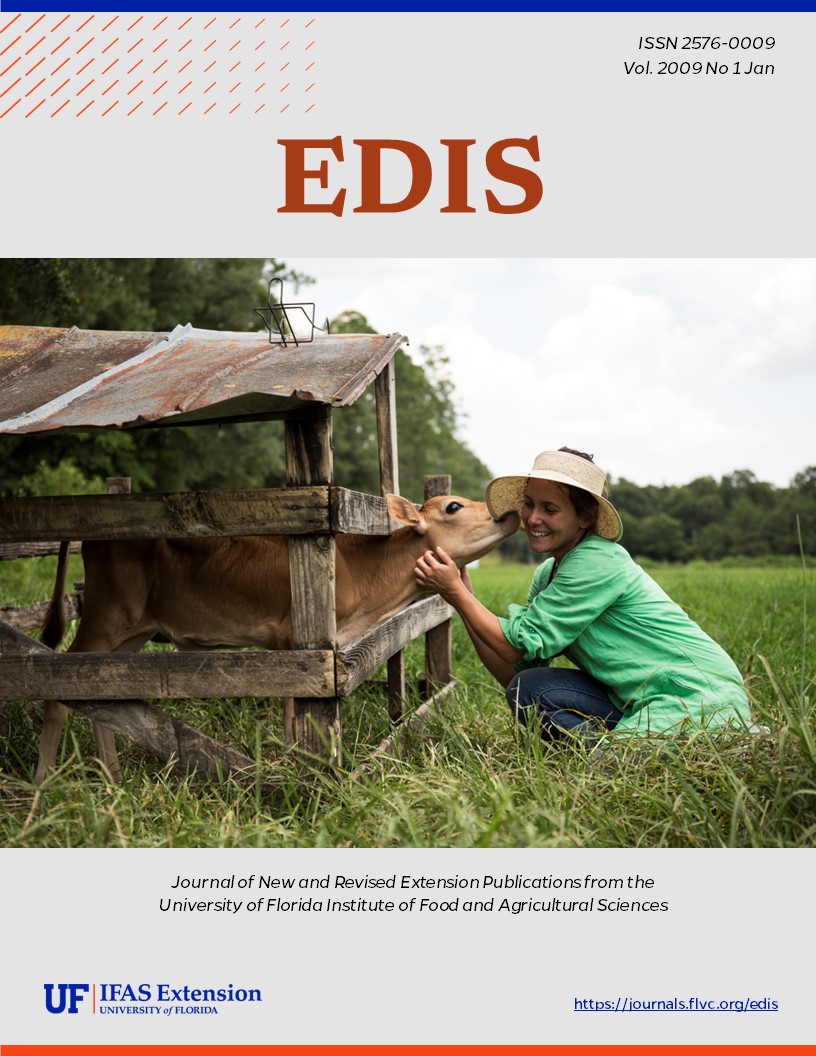Abstract
FE757, a 9-page illustrated fact sheet by Roy R. Carriker and Tatiana Borisova, provides an overview of Florida’s water resources organized with reference to the hydrologic cycle. Includes references. Published by the UF Department of Food and Resource Economics, December 2008.
References
Ackermann, W.C., E.A. Colman, and H.O. Ogrosky (editors). 1955. Where we get our water. Water: The Yearbook of Agriculture. Washington. D.C.: The United States Government Printing Office.
Cervone, S. 2003. Aquifers. Plant Management in Florida Waters website. http://plants.ifas.ufl.edu/guide/aquifers.html
Erwin Raize and Associates (compilers). 1964. Atlas of Florida. Gainesville, FL: The University of Florida Press.
Fernald E.A. and E.D. Purdum (editors). 1998. Water Atlas of Florida. Tallahassee, FL: Institute of Science and Public Affairs, Florida State University.
Florida Department of Environmental Protection (FDEP). 2007. Florida drought conditions: Frequently asked questions. http://www.dep.state.fl.us/Drought/faq.htm
The Florida Springs Task Force. 2000. Florida's Springs Strategies for Protection & Restoration. Springs Task Force Report, State of Florida, Tallahassee, FL. http://www.dep.state.fl.us/springs/reports/files/SpringsTaskForceReport.pdf
Hughes, G.S., E.R. Hampton, and D.F. Tucker. 1971. Annual and seasonal rainfall in Florida, Map series number 40. United States Geological Survey in cooperation with the United States Department of the Interior, Washington, D.C. and the Florida Department of Natural Resources, Bureau of Geology, Tallahassee, FL.
Hyde, L.W. 1975. Principal aquifers in Florida, map series number 16. United States Geological Survey in cooperation with the United States Department of the Interior, Washington, D.C. and the Florida Department of Natural Resources, Bureau of Geology, Tallahassee, FL.
Kenner, W.E., E.R. Hampton, and C.S. Conover. 1971. Average flow of major streams in Florida, map series number 34, Updated. United States Geological Survey in cooperation with the United States Department of the Interior, Washington, D.C. and the Florida Department of Natural Resources, Bureau of Geology, Tallahassee, FL.
Marella, R.L. 2004. Water Withdrawals, Use, Discharge, and Trends in Florida, 2000. Scientific Investigations Report 2004-5151. United States Geological Survey in cooperation with the United States Department of the Interior, Washington, D.C. and the Florida Department of Natural Resources, Bureau of Geology, Tallahassee, FL. https://doi.org/10.3133/sir20045151
McCoy, H.J. and D.B. Sherwood. 1968. Water in Broward County, Florida, map series number 29. United States Geological Survey in cooperation with the United States Department of the Interior, Washington, D.C. and the Florida Department of Natural Resources, Bureau of Geology, Tallahassee, FL (November).
Reichenbaugh, K.C. 1972. Sea-water intrusion in the upper part of the Floridan aquifer in coastal Pasco County, Florida, 1969, map series number 47. United States Geological Survey in cooperation with the United States Department of the Interior, Washington, D.C. and the Florida Department of Natural Resources, Bureau of Geology, Tallahassee, FL.
Scott T.M., G.H. Means, R.P. Meegan, R.C. Means, S.B. Upchurch, R.E. Copeland, J. Jones, T. Roberts, and A. Willet. 2006. Springs of Florida. Bulletin number 66. Florida Department of Environmental Protection, Tallahassee, FL. http://www.dep.state.fl.us/geology/geologictopics/springs/bulletin66.htm
South Florida Water Management District (SFWMD). 2004. Peace River Cumulative Impact Assessment. SFWMD, West Palm Beach, FL. http://www.swfwmd.state.fl.us/waterman/peaceriver/
Spatial Climate Analysis Service, Oregon State University. 2000. Average Annual Precipiration: Florida. http://www.ocs.orst.edu/pub/maps/Precipitation/Total/States/FL/fl.gif
Tinsley, R.K. and J.B. Fransion. 1979. Water Resources Engineering, Third Edition. New York: McGraw-Hill Book Company.
U.S. Environmental Protection Agency (USEPA), Region 4. 2006. Total maximum daily load (TMDL) for fecal and total coliform in the Choctawhatchee River. WBID 49F. USEPA, Washington, D.C. http://epa.gov/region4//water/tmdl/florida/documents/40ChoctawRiver_FCTC_finalMar06_002.pdf
U.S. Geological Service (USGS). 2008. WaterWatch-past streamflow conditions: Table of computed median runoff (mm/day), by water-year, for Florida. USGS, Reston, VA. http://water.usgs.gov/waterwatch/?m=statesum&r=fl&w=statesum%2Cmedian
U.S. Geological Service (USGS). 1995. Description of the ACF River basin study area. Georgia Water Science Center, Atlanta, GA. http://ga.water.usgs.gov/nawqa/basin0.html
U.S. Geological Service (USGS). 2004. Suwannee River Basin and Estuary Initiative: Executive Summary. Open File Report 2004-1198. USGS, Reston, VA. http://gulfsci.usgs.gov/suwannee/reports/es20041198.pdf
USGS. 2008. Water Science for Schools: The Water Cycle. USGS, Reston, VA. http://ga.water.usgs.gov/edu/watercyclesummary.html
Visher, F.N. and G.H. Hughes. 1969. The difference between rainfall and potential evaporation in Florida, map series number 32. United States Geological Survey in cooperation with the United States Department of the Interior, Washington, D.C. and the Florida Department of Natural Resources, Bureau of Geology, Tallahassee, FL (August).

